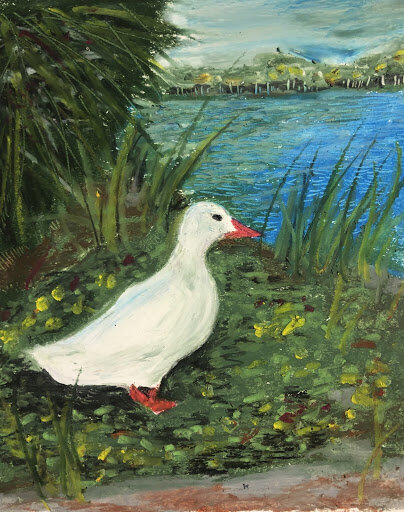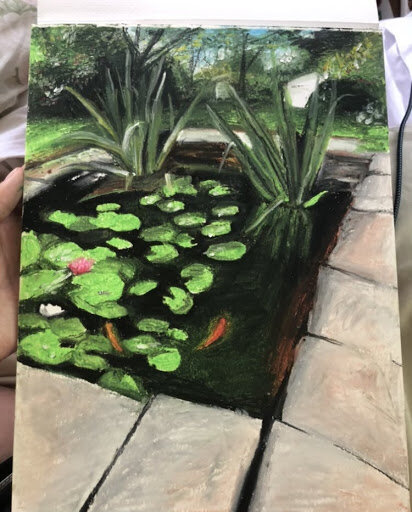Just as COVID-19 has changed how we attend college in 2021, the Spanish influenza changed the lives of Mount Holyoke students in 1918. The stories shared by those students may offer some wisdom and perspective to today’s Mount Holyoke community since they suffered from similar struggles and, at times, extreme sickness. The epidemic of 1918 was documented in the Mount Holyoke News, where students freely shared their experiences and opinions about the situation.
Finally MoHome: Student Experiences Returning To Campus
Ten months after Mount Holyoke’s campus was forced closed due to COVID-19, many students have been able to return to the College.
Though a small number of students lived on campus during the fall of 2020, nearly 800 students are now physically at Mount Holyoke. For some new students, this is the first time they have ever seen the campus in person. For others, it is their final semester.
Students Report Lack of Accessible Sanitary Products During Initial Quarantine
Mount Holyoke has created strict quarantine procedures for students arriving on campus this semester. Students are required to get tested for COVID-19 and quarantine until they receive a negative result. Still, after this test, students are expected to remain on campus for two full weeks. This isolation limits what students have access to, including necessary health products. With van trips to CVS and walks to the Village Commons prohibited, resources are limited to what students can find on campus. For menstruating students, access to sanitary products is essential to staying focused during classes and functioning normally.
Meet Naomi Brown ’21, the Student Chef Behind ‘Platterstagram’
Under normal circumstances, Mount Holyoke students are required to purchase a full on-campus dining plan each year. So when the campus closed in March, students like Naomi Brown ’21 were unexpectedly left with extra household responsibilities and no ready-made meals. Without the options of running to the dining hall between classes or visiting Late Night, Brown has spent the past six months cooking for herself, her family and her roommates. Her dishes, often inspired by music and memories, have even made an appearance on social media. Brown’s self-titled “Platterstagram” (@platterstagram on Instagram) showcases her homemade meals, inventive recipes and themed plates from inside quarantine.
Mount Holyoke Students Share What They Have Been Cooking and Baking From Home
Photo by Ava Provolo ‘22
By Woodlief McCabe ’23
Staff Writer
Without the ease of dining halls and takeout, Mount Holyoke students have found themselves more responsible for their own meals than ever during the pandemic. Restaurant prices and the additional fees of food delivery services have pushed many students to start cooking for themselves.
Tsela Zoksang ’24 started cooking for herself when she moved out of her parents’ house and into an apartment with a roommate. As a first-year, she has been navigating living alone without the buffer of a dorm experience. At first, she was making instant ramen and ordering takeout, but it started to add up. She realized, “Spending a lot of money on a whole bunch of groceries is probably financially unwise when I could just spend $2 here and there on little things.”
However, Zoksang added, “When you have that every day, like two or three times a day, it ends up getting to be way too much. I didn't want to be spending money so recklessly.”
Grocery shopping is a very daunting task for Zoksang. She said that she is able to avoid vegetables and other perishables going bad before she could use them by making large batches of each recipe. “When you make a lot of one thing, you can just leave the leftovers in the fridge, and it will last a long time if you make a lot of it,” she said. This doesn’t mean eating the same thing all week, she clarified.
Aside from being financially beneficial and time-saving, making food provides much-needed downtime. “Cooking is a pretty stress-relieving experience,” she added.
Other students, like Anna Chait ’23, have been cooking since March, when they went back home after campus closed. Chait said, “I started cooking at this time in my life out of force by the pandemic, but honestly, it’s good because cooking is so important and I had been wanting to get into it for years.”
Although for some students cook for themselves only temporarily in college, it can become a lifelong skill. “Cooking has given me a new life skill, and it has let me get more creative with my dishes,” Chait said. “Also, cooking has helped me to achieve a healthier and cheaper eating lifestyle.”
Zoksang spoke about “pockets of control,” a concept which explains ways we can find more peace of mind by creating habits and routines. It doesn’t have to be complicated, “working out or whatever it may be, reading a book a certain time in the day, just one or two things to bring a little more consistency to your life and make you feel like you’re in charge,” Zoksang said. For many students who have lost the consistency of simply leaving the house for class, making meals is a good way to reclaim a sense of time and purpose.
Ava Provolo ’22, who has also been cooking since March, said that she has gained more than just cooking skills and a renewed sense of routine. “I’ve learned my strengths, how to be creative, the importance of food as being joyful. I love making homemade bread and making meals around that,” Provolo said. “Seeing people’s faces when I give them a meal or a platter of something sweet is a great moment.”
Jaia Colognese ’22 has had a love of cooking since childhood when she spent time at her parents’ Italian bakery in Rhode Island. “My parents have instilled in me an appreciation for food that is homemade and handmade,” she said. “I was taught to cook by example, mostly from watching my parents cook dinner together every night.”
Cooking is a passion that she has gotten even closer to these past several months. “I spend hours in the kitchen inventing recipes or modifying ones that I come across,” she said. She finds joy in both the process and the end result. To Colognese, sharing her food “is the best part of cooking.”
Still, as a college student, the recipes she inherited from her family are not always as doable as she would hope. “I grew up in a household that uses the freshest, highest-quality ingredients,” she explained. “If I want to replicate these authentic dishes that my parents and grandparents make, then I need to use these same ingredients, which are often much more expensive.”
Her lifelong love of cooking has taught her as much. “I've learned that there’s a huge difference between fresh basil and dried, fresh versus canned tomatoes, ripe fruit versus supermarket-ripe fruit, and so on,” she said. “High-quality cheese, fruit, vegetables and meat are definitely a barrier for a student, but I try to use these ingredients because it improves the taste of the food significantly.”
While the pandemic has separated many from their loved ones, mealtimes are still one of the best ways to connect with others. For some, the pandemic has brought opportunities to make these times even more personal. “Cooking and baking are my love language[s],” Provolo said. She has been experimenting with her own veggie burger recipes.
Chait has been making all sorts of pescatarian meals and other meatless dishes for her partner, as well as baking, which she says has been a pastime of hers since before the pandemic. Provolo is also baking, preparing for a “12 type [of] cookie marathon” come December, as well as making a fudge and chocolate cake.
Despite the physical distance, some students, like Zoksang, are connecting to their families through recipes. Zoksang thinks of her father when she cooks. Her father fled Tibet to a refugee school in India where he wasn’t able to cook for himself.
“Once he actually had the resources to start cooking, he always loved to,” she explained. “In Tibetan culture, cooking and having family time for eating and drinking tea together is a big deal, and so he’s always cooked much more … than my mom did. And I always liked to help him as a kid. We’d make what’s called momo, which is like dumplings.”
Provolo, who has Italian roots, also recognized the great familial bond that cooking can bring. “Food connects my family together every day at supper,” she said. “I also learned a lot about how to cook from my grandmother, who has shown me most importantly how to put love into food.”
The way we feed ourselves can help us find routine in the chaotic lives we have been thrown into. We can have time to think about loved ones far away and show our appreciation for the ones we have the fortune to be close to. If you aren’t cooking with your family, friends or partner in the room, the things we add to the food and the people we share it with can still bring the warmth of a shared meal.
Cooking is an incredibly meditative and productive act in a way that few others are. It also opens up room for creativity through experimentation with new ingredients and ideas. We can make mistakes and burn our food and spill everything and make huge messes. We will never not need to have meals, so why not take the time to create joy and warmth when we can?
Food is filling, but cooking has the power to be fulfilling.
• Anna Chait — Pumpkin Cookies
Ingredients
For cookies:
1 cup butter, softened
2/3 cup packed brown sugar
1/3 cup granulated sugar
1 egg
1-1 ½ teaspoons vanilla extract
1 cup canned pumpkin
2 cups flour
1 ½-2 teaspoons of cinnamon
1 teaspoon baking soda
½ teaspoon salt
¼ teaspoon baking powder
Walnuts (optional)
For frosting:
¼ cup butter
4 ounces cream cheese
2 cups confectioner’s sugar
1 ½-2 teaspoons vanilla extract
Tip: I usually add 2 teaspoons of vanilla extract (especially if using imitation vanilla extract). Also, if you need more frosting but don’t want to double the recipe, you can just add more confectioner’s sugar!
Instructions
Preheat the oven to 350 F. In a large bowl, cream butter and sugars until light and fluffy. Beat in egg and vanilla. Add pumpkin; mix well. In a separate bowl, combine the flour, cinnamon, baking soda, salt and baking powder; gradually add to the creamed mixture and mix well. Drop by rounded tablespoonfuls 2 inches apart onto greased baking sheets. Bake for 8-10 minutes or until edges are lightly browned. Cool completely. In a small bowl, beat the frosting ingredients until light and fluffy. Frost cookies and store in an airtight container in the refrigerator.
• Tesla Zoksang — Jigae (Korean Stew)
(Meat can be substituted for tofu or anything else.)
Serves 2-4
Ingredients
1 medium potato, peeled and cut into ½-inch cubes (about 1 cup)
1 medium onion, cut into ½-inch pieces (about 1 cup)
1 small zucchini, cut into ½-inch pieces (about 1 cup)
1 green Korean chili pepper (cheong-gochu), stemmed and chopped
4 garlic cloves, minced
4 large shrimp, shelled, deveined, washed and coarsely chopped (about ⅓ cup)
2 ½ cups water
7 dried anchovies, guts removed
5 tablespoons fermented soybean paste (doenjang)
6 ounces medium-firm tofu, cut into ½-inch cubes (about 1 cup)
2 green onions, chopped
Homemade doenjang (집된장)
Instructions
Combine the potato, onion, zucchini, chili pepper, garlic and shrimp in a 1½-quart (6 cups) earthenware pot or other heavy pot. Wrap the dried anchovies in cheesecloth (or a dashi bag, a pouch for stock-making sold at Korean grocery stores) and put them into the pot with other ingredients. Add water and cover.
Cook over medium-high heat for 15 minutes or until it starts boiling. If you use a stainless steel pot, it will take less than 15 minutes, about 7 to 8 minutes.
Stir in the soybean paste, mixing well. Cover and cook for 20 minutes longer over medium heat.
Add the tofu and cook for another 3 minutes. Remove the anchovy pouch and discard.
Sprinkle with the green onions and serve as a side dish to rice. Serve it directly from the pot or transfer to a serving bowl. Everybody can eat together out of the pot or portions can be ladled out into individual bowls for each person.
To Zoksang, the most important ingredients are the condiments, like the spices and pastes. That way you can keep your cooking interesting and new without spending a ton of money. She finds the pastes for her Korean cooking at H-Mart, an Asian grocery store near her apartment in Manhattan.
• Jaia Colognese — Blue Cheese Steak with Cracked Black Pepper
(Serves 2)
Ingredients
2 high-quality (preferably local) ribeye or New York strip steaks
¼ pound of blue cheese, such as Cambozola
3 tablespoons room temperature butter
1 teaspoon finely chopped chives (optional)
2 teaspoons freshly cracked black pepper (or to taste)
2 teaspoons finely minced garlic
Instructions
Preheat your grill or prepare a cast iron pan for cooking. Pat the steaks dry, cover with a light salt/pepper rub and allow them to sit for about 10 minutes. In the meantime, prepare the butter. Mix room temperature butter with cheese, garlic, chives and black pepper. Set aside for later.
Cook the steaks to your liking, allowing them to rest for about 5 minutes once removed from heat. Plate the steaks, slathering them in blue cheese spread.
Sides to enjoy this with:
Caramelized onions and brussel sprouts
Balsamic-glazed carrots
Oven-roasted potatoes
Pandemica
Graphic by Anjali Rao-Herel ‘22
By Woodlief McCabe ’23
Staff Writer
Staple Meal
If you’re living at home again, or even living in your own place off-campus, making sure you eat well and often may seem like an unattainable goal. There are plenty of ready-made single-serving meals out there that you can microwave or pour boiling water over — but you already knew that, you’re a college student.
These Troubling Times have thrown us unexpectedly from the coddling arms of the educational institution to the cold harsh world of Getting Groceries Every Week? Oh My God, When Does It End?
One of the best ways to survive is off of leftovers. What you’re going to want to do is make a large helping of a meal, preferably something simple that will last in the fridge. I make several cups of rice seasoned with lemon pepper and a little tomato paste for color and flavor. I heat up some beans, put it in a bowl with cheese, tomatoes, sour cream and avocado (if I just got paid). It’s filling, tasty and contains the major food groups. Once you’re done, put the rest in the fridge and all you have to do is heat it up when you’re hungry.
Keeping rice on hand is a lifesaver. If your vegetables are about to go bad, throw them in a stir fry with the rice and an egg, and boom! Fried rice. A pot of soup is also a great choice. Be sure to eat bread or rice with it to feel fancy and make the meal more substantial.
Bonus tip: dipping pretty much any toasted bread in olive oil will make you feel like you’re a European aristocrat and not someone sitting in their kitchen eating four slices of bread for dinner.
Go Find a Dog
“Go for a walk, get out in nature, go outside!” These are things we always hear when it comes to self-care. And while they are admittedly effective, motivation can be hard to come by. Sometimes it feels like wandering aimlessly outside doesn’t make sense, especially when there are plenty of things to do inside. Instead, make a partial plan. You can run an errand, or find a place to stop and make art, or take photos or eat lunch. If you’re stressed out, sometimes the solitude of just leaving your house spontaneously can really help get your head back on straight.
The other great thing about the outside is that there are dogs there.
Figure out where people in your area walk their dogs. You might live near a trail or a walking path. Parks are usually a great spot since you can stop and watch all the dogs come through the park. As long as you have a mask on, a good portion of people will let you pet their dogs or even throw a ball or frisbee for them. Make sure to always ask before you pet the dog, and hold out the back of your hand for them to sniff first.
Mount Holyoke Students Share Their Quarantine Projects
By Woodlief McCabe ’23
Staff Writer
This summer and fall looked different for all of us. The time when we would normally be going out and enjoying the company of others was transformed into a time of solitude and anxiety. Mount Holyoke students, just like people all around the world, have found ways to deal with feelings of isolation via the power of creation. Here, students share their work from various media and styles, reminding us that art and creation haven’t gone anywhere.
Gina Pasciuto ’23 has spent quarantine making embroidery art that she showcases on her Instagram @cursedembroidery. “I’ve been working on embroidery as a way to keep my hands and mind busy since Christmas, and the skills I’m picking up have been very useful during the pandemic,” she said. Her commissions are currently open.
Cadence Cordell ’23 has spent quarantine with a needle and thread. “Sewing has really helped me keep calm during quarantine, and, during Zoom classes, helps me stay focused on the lesson at hand,” she said. “I hand sew the stuffed animals and, with my new sewing machine, have recently started making clothes as well.”
Maggie Kamb ’22 shares her “gay vampire art.” These two characters have been featured in her art before. She describes the first piece as “before quarantine” and the second two as “after quarantine.”
During quarantine, Autumn Lee ’24 opened an Etsy store named SoleilTies where she makes and sells bandanas for dogs. “I pretty much decided to do this because I have recently gotten back into sewing and I have been spending a lot of time with dogs lately,” Lee said. “This seemed like a sensible thing to do.”
Emily Eayrs ’23 has been sketching over quarantine.
Phoebe Murtagh ’21 has been working on this skull afghan for eight years, but has been especially productive since the end of last semester. “I was working on it in between finishing the semester and finding an internship. At the time my city was pretty much shut down, so audiobooks and crafts occupied a fair amount of my time,” she said. She spent this summer piecing together the hand-crocheted skulls and attaching the long strips of the skulls together in an offset pattern. “The multi-step process and the sheer size of the project is why I've been taking so long at it,” Murtagh said.
In August, Jalia Nazerali-Ruddy ’24 created these two drawings, one of Harry Potter (right) and one of a tiger (left).
Tory Halsey ’23 has made these oil pastel pieces of natural scenes. Halsey attempts to give Mount Holyoke students a little bit of MoHome sickness with her portrait of Jorge. She has also been constructing a tank for her aquascape where she keeps aquatic snails and plants.
Students Living on Campus This Fall Share Experiences
Graphic by Trinity Kendrick ‘22
By Rebecca Gagnon ’23
Staff Writer
On Aug. 7, Mount Holyoke announced that it would not be allowing the vast majority of students to live on campus during the pandemic. The only students who were permitted to remain were those who had applied to live on campus under circumstances that could not be resolved. According to Vice President for Student Life and Dean of Students Marcella Runell Hall, as of Aug. 13, there were about 180 students on campus.
“It’s really sad around here,” Samira Khan ’22, who currently lives on campus, said. “It just feels like you are living in a zombie land.”
Khan, who is from Bangladesh, describes herself as a semi-domestic and international student. She spent part of the summer in Bangladesh and then applied to stay on campus for the school year. When she was approved, she went to spend a week with family near Mount Holyoke. “I was already in this county and I was staying with my relatives [on] just a temporary basis and then, just a week later, [Mount Holyoke administration] said we [were] going online,” Khan said. “I didn’t have a place because it was just a one-week [plan] and this was my only option.”
This story resonated with others who are staying on campus. Parikshita Gya ’22 is another international student living on campus who was afraid to go home. Gya described not living in good studying conditions back home, a large reason for staying on campus. Additionally, Gya mentioned being “very afraid of [President Donald] Trump pulling one of his cards again and barring us entry.”
Although there are some people who are still on campus on a regular basis, both faculty and students feel that there has been an unwelcome change this semester.
“It’s just really isolating,” Emily Jones ’23, another student living on campus, stated. “I don’t know, I just think that everyone is trying to get through it.”
“My impression from my horror movie background,” Professor of Biological Sciences Gary Gillis said, “is it just feels like a zombie apocalypse about to start and I am sad that so many people are missing out on this amazing opportunity in this cool space.” Gillis is an associate dean of faculty, the director of the Science Center and a professor in the biological sciences department who is currently working from home.
As a member of the College’s administration, Gillis said, “It was kind of my job to convey to the faculty that this last spring and summer we were really trying to de-densify the campus. … The easiest thing for me in deciding to work from home was kind of just abiding by the philosophy I was telling everyone else.”
Other professors decided to work from home as well, for the safety of co-workers and students. “The best part [of working from home],” Morena Svaldi, lecturer in Italian and the faculty director of the Language Assistant program, said, “is that I can switch my roles very quickly. The difficult part, I think, is that there is no separation between your personal life, personal space and professional space.”
This is a difficulty faced by students who are still living on campus as well. “Normally I would go to classes,” Khan said. “But now it’s just like, wake up, go to your desk, study and then whenever your lunch or dinner time is, you go out for just that. It’s sad.”
The rules that are being enforced now are the same rules that all students who were previously planning to live on campus would have to abide by. The only difference is that it is now embedded in the community compact for Mount Holyoke to maintain safety on campus.
“There are several restrictions and the community compact was [originally] so vague that you didn’t even know when you might breach it,” Gya recalled.
At the beginning of the new year, there was a miscommunication between Dining Services and Residential Life that resulted in some students unintentionally breaking the community compact by sitting and eating in the Dining Commons. There had previously been no signs or notices about whether that was allowed or not.
“Trying to have a good day and just having food and then out of the blue someone comes up to you and tells you, ‘Oh, you breached the law on campus, we need to take your name and report you,’ is, in itself, very scary,” Gya said. “Especially for us international students; we have nowhere else to go.”
After this incident, the students did not get penalized for eating in the Dining Commons, since there was a miscommunication. Signs were put up soon after around the Dining Commons so students would know that they are not allowed to eat there. Students are only allowed to eat outside or in their rooms.
Some dorm kitchenettes are open for students to cook their own food if they want to, which helps offset Dining Services’ limited hours. “Their lunch and breakfast times clash with most class times,” Bineeta Debnath ’23 said.
“As the weather is on our side right now, it is better that we get to go outside and have dinner with our friends who are living in other dorms, but I don’t know what is going to happen during wintertime,” Khan said. “We will be staying in our rooms the whole time; even if we are getting our food, we are coming back to our rooms and we are eating in the same space, so it is going to get toxic.”
Other students such as Jones, Debnath and Gya shared this concern for the mental and physical health of the students living on campus. Students can currently spend time with friends from other dorms by going outside because they are not allowed to enter any dorm that is not their own. They may spend time together in Blanchard Hall, but it has to be socially distanced with masks on.
“We don’t really have a social life,” Gya said. “It is just us in one room and I think [for] people struggling with mental illness, this is going to be really harsh on them.”
According to students living on campus, Residential Life is holding some online events and putting on small get-togethers in dorms to help them feel less isolated. Along with this, according to the students interviewed, those permanently residing on campus are allowed to spend time with people who are in their dorm as well.
Professors also shared this concern for students’ mental and physical health and are continuing to check in with their students.
“I really care a lot about how my students are processing this because I know that some students have different situations,” Svaldi said. “This has impacted the way that we learn and recharge ourselves, so my message is to be nice to ourselves and be supportive to those around us.”
Although there are a lot of negative feelings, some students have been able to find the silver linings.
“It’s hard,” Khan said. “Especially the two [COVID-19] tests per week, but it is helping to keep us on track, like ‘Okay I’m safe, my friends are safe, the people I’m sharing the bathroom with are safe.’ … [COVID-19]-wise, the campus is safe and they are taking good care of us in that way.”
“I am really grateful for the people around me,” Gya said. “As in ResLife people, the professors, people in the Dining Services — I feel like they worked really, really hard. … They are amazing. They are doing so much for us, they don’t even know us and they are so nice. Although they are struggling, they are trying to make your day better. … I think we should all feel really special that they care about us that much.”






















